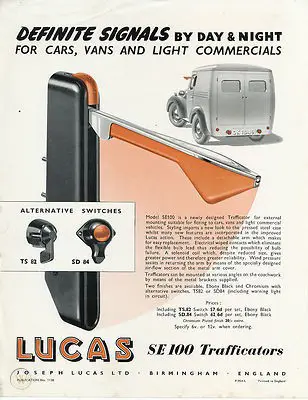THE HISTORY OF DIRECTION INDICATOR
18 January 2022
Or the story of a device that we all take for granted…
- Oscar A. Waltz, Jr patents a ‘turn signal’, but it never enters production.
- Oscar J. Simler devises a new form of a traffic signal with an array of lights. Arrows denote left and right turns, augmented by a yellow brake light and a red ‘Stop’ lamp. But, alas, it did not catch on.
- Morris fit all models asides from the Minor with the latest ‘Wilcot Robot’ traffic indicator. These were vertical blocks of red, amber and green lamps for turns and braking mounted on both sides of the car beneath the A-pillars. One reason for their introduction is that Lord Nuffield was loath to pay royalties to Lucas, the producer of semaphore trafficators. Unfortunately, the Ministry of Transport disapproved of the new set-up.
- Buick becomes the first car maker to offer flashing direction indicators, albeit as an optional extra. Drivers operated the “Flash-Way Directional Signal” via a “Handi-shift” column-mounted control.
- Buick adds indicators at the front, and they are now standard equipment, as with Cadillac, LaSalle, and the ‘Country Club’ Hudson models. Turn signals remain an option for Chevrolet, other Hudsons, Oldsmobile, Packard and Pontiac.
- Indicators are now optional on all Dodge models.
- Hazard warning lights are introduced as an aftermarket accessory for US cars. At that time, turn signals were still an optional extra on several entry-level Detroit cars. Meanwhile, across the Atlantic, the Minister of Transport declined to make trafficators mandatory fitting on cars, buses and lorries. “I do not think the time is opportune. The supply position is difficult, and there are technical problems in the fitting of these devices to heavier vehicles which have still to be solved”.
- Flashing indicators are now a legally approved flitting on British cars, although a few models had been so equipped for the previous few years. The American export market was one major impetus.
- The Road Research Laboratory recommends that indicators be amber, of an intensity between 100 and 500 candlepower, be mounted on the side of a vehicle at the level of the driver’s eye, and emit light forwards, backwards, and at right angles.
- The demise of the Austin A35 Countryman also marks the end of the last British car fitted with trafficators, although the saloons had boasted amber flashers on their introduction in 1956. Accessory shops continue to offer conversion kits for older models equipped with semaphores for many more years.

1935. Amber flashing indicators fore and aft are now a legal requirement on new cars sold in the UK.
1968 The Federal Motor Vehicle Safety Standard 108 requires new cars sold in the USA to have amber front indicators; those at the rear can be either red or amber.
- Hand signals cease to be a part of the driving test.
